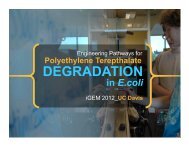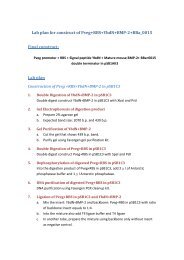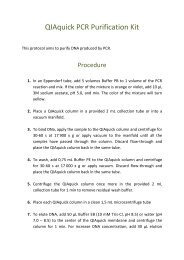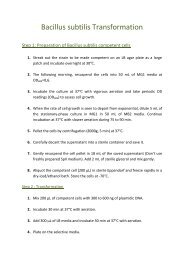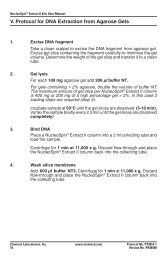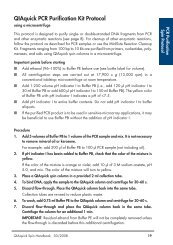Caffeine and related purine alkaloids: Biosynthesis ... - iGEM 2012
Caffeine and related purine alkaloids: Biosynthesis ... - iGEM 2012
Caffeine and related purine alkaloids: Biosynthesis ... - iGEM 2012
Create successful ePaper yourself
Turn your PDF publications into a flip-book with our unique Google optimized e-Paper software.
Available online at www.sciencedirect.com<br />
PHYTOCHEMISTRY<br />
Phytochemistry 69 (2008) 841–856<br />
Review<br />
<strong>Caffeine</strong> <strong>and</strong> <strong>related</strong> <strong>purine</strong> <strong>alkaloids</strong>: <strong>Biosynthesis</strong>, catabolism,<br />
function <strong>and</strong> genetic engineering<br />
Hiroshi Ashihara a , Hiroshi Sano b , Alan Crozier c, *<br />
a Department of Biological Sciences, Graduate School of Humanities <strong>and</strong> Sciences, Ochanomizu University, Otsuka, Bunkyo-ku, Tokyo 112-8610, Japan<br />
b Botanical Institute, Stockholm University, Stockholm 106 91, Sweden<br />
c Graham Kerr Building, Division of Environmental <strong>and</strong> Evolutionary Biology, Institute of Biomedical <strong>and</strong> Life Sciences,<br />
University of Glasgow, Glasgow G12 8QQ, UK<br />
Received 14 October 2007; accepted 15 October 2007<br />
Available online 19 December 2007<br />
www.elsevier.com/locate/phytochem<br />
Abstract<br />
Details of the recently elucidated biosynthetic pathways of caffeine <strong>and</strong> <strong>related</strong> <strong>purine</strong> <strong>alkaloids</strong> are reviewed. The main caffeine biosynthetic<br />
pathway is a sequence consisting of xanthosine 7-methylxanthosine 7-methylxanthine theobromine caffeine. Genes<br />
encoding N-methyltransferases involved in three of these four reactions have been isolated <strong>and</strong> the molecular structure of N-methyltransferases<br />
investigated. Pathways for the catabolism of caffeine have also been studied, although there are currently no reports of enzymatic<br />
<strong>and</strong> genetic studies having been successfully carried out. Metabolism of <strong>purine</strong> <strong>alkaloids</strong> in species including Camellia, Coffea, Theobroma<br />
<strong>and</strong> Ilex plants is summarised, <strong>and</strong> evidence for the involvement of caffeine in chemical defense <strong>and</strong> allelopathy is discussed. Finally,<br />
information is presented on metabolic engineering that has produced coffee seedlings with reduced caffeine content, <strong>and</strong> transgenic caffeine-producing<br />
tobacco plants with enhanced disease resistance.<br />
Ó 2007 Elsevier Ltd. All rights reserved.<br />
Keywords: Camellia sinensis; Theaceae; Coffea sp.; Rubiaceae; Theobroma cacao; Sterculiaceae; Review; Metabolism; <strong>Caffeine</strong><br />
Contents<br />
1. Introduction . . . . . . . . . . . . . . . . . . . . . . . . . . . . . . . . . . . . . . . . . . . . . . . . . . . . . . . . . . . . . . . . . . . . . . . . . . . . . . . 842<br />
2. <strong>Caffeine</strong> biosynthesis . . . . . . . . . . . . . . . . . . . . . . . . . . . . . . . . . . . . . . . . . . . . . . . . . . . . . . . . . . . . . . . . . . . . . . . . . 842<br />
2.1. <strong>Caffeine</strong> biosynthesis from xanthosine . . . . . . . . . . . . . . . . . . . . . . . . . . . . . . . . . . . . . . . . . . . . . . . . . . . . . . . . 843<br />
2.2. Supply of xanthosine for caffeine biosynthesis . . . . . . . . . . . . . . . . . . . . . . . . . . . . . . . . . . . . . . . . . . . . . . . . . . 843<br />
3. N-Methyltransferases involved in caffeine biosynthesis. . . . . . . . . . . . . . . . . . . . . . . . . . . . . . . . . . . . . . . . . . . . . . . . . . 844<br />
3.1. Genes. . . . . . . . . . . . . . . . . . . . . . . . . . . . . . . . . . . . . . . . . . . . . . . . . . . . . . . . . . . . . . . . . . . . . . . . . . . . . . . 844<br />
3.2. Molecular structure of caffeine biosynthesis enzymes . . . . . . . . . . . . . . . . . . . . . . . . . . . . . . . . . . . . . . . . . . . . . 845<br />
4. Catabolism of caffeine . . . . . . . . . . . . . . . . . . . . . . . . . . . . . . . . . . . . . . . . . . . . . . . . . . . . . . . . . . . . . . . . . . . . . . . . 845<br />
5. Metabolism of <strong>purine</strong> <strong>alkaloids</strong> in individual species . . . . . . . . . . . . . . . . . . . . . . . . . . . . . . . . . . . . . . . . . . . . . . . . . . . 847<br />
5.1. Camellia species . . . . . . . . . . . . . . . . . . . . . . . . . . . . . . . . . . . . . . . . . . . . . . . . . . . . . . . . . . . . . . . . . . . . . . . 847<br />
5.2. Coffea species . . . . . . . . . . . . . . . . . . . . . . . . . . . . . . . . . . . . . . . . . . . . . . . . . . . . . . . . . . . . . . . . . . . . . . . . . 848<br />
5.3. Theobroma <strong>and</strong> <strong>related</strong> species. . . . . . . . . . . . . . . . . . . . . . . . . . . . . . . . . . . . . . . . . . . . . . . . . . . . . . . . . . . . . 849<br />
5.4. Maté ............................................................................... 850<br />
5.5. Other species . . . . . . . . . . . . . . . . . . . . . . . . . . . . . . . . . . . . . . . . . . . . . . . . . . . . . . . . . . . . . . . . . . . . . . . . . 850<br />
* Corresponding author. Tel.: +44 141 330 4613; fax: +44 141 330 5394.<br />
E-mail addresses: ashihara.hiroshi@ocha.ac.jp (H. Ashihara), sano@gtc.naist.jp (H. Sano), a.crozier@bio.gla.ac.uk (A. Crozier).<br />
0031-9422/$ - see front matter Ó 2007 Elsevier Ltd. All rights reserved.<br />
doi:10.1016/j.phytochem.2007.10.029
842 H. Ashihara et al. / Phytochemistry 69 (2008) 841–856<br />
6. Role of <strong>purine</strong> <strong>alkaloids</strong> in planta ................................................................ 850<br />
6.1. Chemical defence . . . . . . . . . . . . . . . . . . . . . . . . . . . . . . . . . . . . . . . . . . . . . . . . . . . . . . . . . . . . . . . . . . . . . . 850<br />
6.2. Allelopathy . . . . . . . . . . . . . . . . . . . . . . . . . . . . . . . . . . . . . . . . . . . . . . . . . . . . . . . . . . . . . . . . . . . . . . . . . . 851<br />
7. Genetic engineering of caffeine . . . . . . . . . . . . . . . . . . . . . . . . . . . . . . . . . . . . . . . . . . . . . . . . . . . . . . . . . . . . . . . . . . 851<br />
7.1. Decaffeinated coffee plants . . . . . . . . . . . . . . . . . . . . . . . . . . . . . . . . . . . . . . . . . . . . . . . . . . . . . . . . . . . . . . . . 851<br />
7.2. Natural pesticides . . . . . . . . . . . . . . . . . . . . . . . . . . . . . . . . . . . . . . . . . . . . . . . . . . . . . . . . . . . . . . . . . . . . . . 852<br />
8. Summary <strong>and</strong> perspectives . . . . . . . . . . . . . . . . . . . . . . . . . . . . . . . . . . . . . . . . . . . . . . . . . . . . . . . . . . . . . . . . . . . . . 853<br />
Acknowledgements . . . . . . . . . . . . . . . . . . . . . . . . . . . . . . . . . . . . . . . . . . . . . . . . . . . . . . . . . . . . . . . . . . . . . . . . . . 853<br />
References . . . . . . . . . . . . . . . . . . . . . . . . . . . . . . . . . . . . . . . . . . . . . . . . . . . . . . . . . . . . . . . . . . . . . . . . . . . . . . . . 853<br />
1. Introduction<br />
Purine <strong>alkaloids</strong> are secondary metabolites derived from<br />
<strong>purine</strong> nucleotides (Zulak et al., 2006) that have been found<br />
in nearly 100 species in 13 orders of plant kingdom<br />
(Ashihara <strong>and</strong> Crozier, 1999a). Methylxanthines, such as<br />
caffeine (1,3,7-trimethylxanthine) <strong>and</strong> theobromine (3,7-<br />
dimethylxanthine), <strong>and</strong> methyluric acids are classified as<br />
<strong>purine</strong> <strong>alkaloids</strong> (Fig. 1). They occur in tea, coffee <strong>and</strong> a<br />
number of other non-alcoholic beverages. <strong>Caffeine</strong> was isolated<br />
from tea <strong>and</strong> coffee in the early 1820s, but the main biosynthetic<br />
<strong>and</strong> catabolic pathways of caffeine were not fully<br />
established until 2000. Highly purified caffeine synthase<br />
was obtained from tea leaves after which a gene encoding<br />
Fig. 1. Purine alkaloid structures based on xanthine <strong>and</strong> uric acid<br />
skeletons.<br />
the enzyme was cloned (Kato et al., 1999, 2000). This facilitated<br />
molecular studies on the regulation of caffeine production<br />
principally with coffee plants (Ogita et al., 2003).<br />
This review describes biosynthesis <strong>and</strong> catabolism of <strong>purine</strong><br />
<strong>alkaloids</strong>, <strong>and</strong> the genes <strong>and</strong> molecular structure of N-methyltransferases<br />
<strong>related</strong> to caffeine biosynthesis. In addition,<br />
details are included on <strong>purine</strong> metabolism in a number of<br />
plants including Camellia, Coffea, Theobroma <strong>and</strong> Ilex species.<br />
The emerging role of <strong>purine</strong> <strong>alkaloids</strong> in planta <strong>and</strong><br />
metabolic engineering of caffeine are also discussed.<br />
2. <strong>Caffeine</strong> biosynthesis<br />
Main caffeine biosynthetic pathway is a four step<br />
sequence consisting of three methylation <strong>and</strong> one nucleosidase<br />
reactions (Fig. 2). The xanthine skeleton of caffeine is<br />
derived from <strong>purine</strong> nucleotides. The initial step in caffeine<br />
biosynthesis is the methylation of xanthosine by a SAMdependent<br />
N-methyltransferase. In addition to experiments<br />
with radiolabelled precursors, substrate specificities of<br />
native (Kato et al., 1999) <strong>and</strong> recombinant N-methyltransferases<br />
(Kato et al., 2000; Ogawa et al., 2001; Mizuno et al.,<br />
2003a,b; Uefuji et al., 2003) strongly suggest that the major<br />
route to caffeine is a xanthosine 7-methylxanthosine<br />
7-methylxanthine theobromine caffeine pathway<br />
(Fig. 2). Although the information has been<br />
obtained mainly from coffee (Coffea arabica) <strong>and</strong> tea<br />
(Camellia sinensis), the available evidence indicates that<br />
the pathway is essentially the same in other <strong>purine</strong> alkaloid-forming<br />
plants, such as maté (Ilex paraguariensis –<br />
Ashihara, 1993) <strong>and</strong> cacao (Theobroma cacao – Koyama<br />
et al., 2003; Yoneyama et al., 2006).<br />
Fig. 2. The major biosynthetic pathway of caffeine from xanthosine: (1) 7-methylxanthosine synthase (xanthosine N-methyltransferase); (2) N-<br />
methylnucleosidase; (3) theobromine synthase (monomethylxanthine N-methyltransferase); (4) caffeine synthase (dimethylxanthine N-methyltransferase);<br />
(3–4) dual-functional caffeine synthase (EC 2.1.1.160). Several N-methyltransferases with different substrate specificities contribute to the conversion of<br />
xanthosine to caffeine (see Section 3). Recent observations suggest that steps 1 <strong>and</strong> 2 are catalysed by xanthosine N-methyltransferase. SAM, S-adenosyl-Lmethionine;<br />
SAH, S-adenosyl-L-homocysteine.
H. Ashihara et al. / Phytochemistry 69 (2008) 841–856 843<br />
2.1. <strong>Caffeine</strong> biosynthesis from xanthosine<br />
The first step in the biosynthetic pathway of caffeine<br />
from xanthosine is the conversion of xanthosine to 7-methylxanthosine<br />
(Fig. 2). This reaction is catalysed by 7-methylxanthosine<br />
synthase (xanthosine 7N-methyltransferase,<br />
EC 2.1.1.158). The genes encoding 7-methylxanthosine<br />
synthase, CmXRS1 (AB 034699) <strong>and</strong> CaXMT1<br />
(AB048793), were isolated from C. arabica (Mizuno<br />
et al., 2003a; Uefuji et al., 2003). The recombinant proteins<br />
obtained from these genes exhibit 7-methylxanthosine synthase<br />
activity in vitro. Although Schulthess et al. (1996)<br />
proposed the inclusion of 7-methyl-XMP in caffeine biosynthesis<br />
pathway in coffee, XMP is not converted to 7-<br />
methylxanthosine by the recombinant enzymes.<br />
The second step of caffeine biosynthesis involves a nucleosidase<br />
which catalyses the hydrolysis of 7-methylxanthosine.<br />
Although N-methylnucleosidase (EC 3.2.2.25) was<br />
partially purified from tea leaves by Negishi et al. (1988),<br />
isolation of the native enzyme as well as DNA encoding<br />
the enzyme has not yet been achieved. Recent detailed<br />
structural studies on coffee 7-methylxanthosine synthase<br />
suggested that the methyl transfer <strong>and</strong> nucleoside cleavage<br />
may be coupled <strong>and</strong> catalysed by a single enzyme (McCarthy<br />
<strong>and</strong> McCarthy, 2007).<br />
The last two steps of caffeine synthesis are also catalysed<br />
by SAM-dependent N-methyltransferase(s), but this<br />
enzyme is different from the N-methyltransferase that<br />
catalyses the first step in the pathway. Native N-methyltransferase<br />
activities have been detected in crude <strong>and</strong> partially<br />
purified extracts from tea <strong>and</strong> coffee plants (see<br />
Suzuki et al., 1992; Ashihara <strong>and</strong> Suzuki, 2004), <strong>and</strong> a<br />
highly purified preparation has been obtained from young<br />
tea leaves (Kato et al., 1999). The enzyme, assigned the<br />
name caffeine synthase (EC 2.1.1.160), catalyses the last<br />
two steps of caffeine biosynthesis, the conversion of 7-<br />
methylxanthine to caffeine via theobromine (Fig. 2). The<br />
gene encoding caffeine synthase was cloned from young<br />
tea leaves by Kato et al. (2000). Since then, plural genes<br />
encoding N-methyltransferases which have different substrate<br />
specificities have been reported (see Section 3.1).<br />
Activity of the recombinant theobromine synthase<br />
(CTS1 <strong>and</strong> CaMXMT, EC 2.1.1.159) is specific for the conversion<br />
of 7-methylxanthine to theobromine. In contrast,<br />
the recombinant caffeine synthases (CCS1 <strong>and</strong> CaDMXT1)<br />
can utilise paraxanthine, theobromine <strong>and</strong> 7-methylxanthine<br />
as shown with tea caffeine synthase (TCS1) (see Section<br />
3.1). Although paraxanthine is the most active<br />
substrate of this recombinant enzyme, only limited<br />
amounts of paraxanthine are synthesized in coffee cells so<br />
in vivo caffeine synthase is involved principally in the conversion<br />
of 7-methylxanthine to caffeine via theobromine.<br />
Radiolabelled tracer experiments with theobromineaccumulating<br />
cacao <strong>and</strong> a Chinese tea (Camellia ptilophylla)<br />
showed a limited conversion of theobromine to<br />
caffeine. N-Methyltransferase activity which catalysed the<br />
conversion of 7-methylxanthine to theobromine, but not<br />
theobromine to caffeine, was detected in crude extracts<br />
from C. ptilophylla (Ashihara et al., 1998). Recently, genes<br />
homologous to caffeine synthase have been isolated from<br />
several theobromine-accumulating plants including cacao<br />
(Yoneyama et al., 2006). The recombinant enzymes derived<br />
from these genes have only 3-N-methyltransferase activity.<br />
Therefore, in these theobromine-accumulating plants, specific<br />
theobromine synthases are present. <strong>Caffeine</strong> does not<br />
occur in C. ptilophylla (Ashihara et al., 1998) although it<br />
is present in leaves <strong>and</strong> fruits of cacao along with theobromine<br />
(Koyama et al., 2003; Zheng et al., 2004). Genes<br />
encoding caffeine synthase appear, therefore, to be present<br />
in cacao but not the Chinese tea plants.<br />
2.2. Supply of xanthosine for caffeine biosynthesis<br />
Xanthosine, the initial substrate of <strong>purine</strong> alkaloid synthesis,<br />
is supplied by at least four different pathways: de<br />
novo <strong>purine</strong> biosynthesis (de novo route), the degradation<br />
pathways of adenine nucleotides (AMP route) <strong>and</strong> guanine<br />
nucleotides (GMP route), <strong>and</strong> the S-adenosyl-L-methionine<br />
(SAM) cycle (SAM route) (Fig. 3).<br />
Purine nucleotides are synthesized by de novo <strong>and</strong> salvage<br />
pathways (Ashihara <strong>and</strong> Crozier, 1999a; Stasolla<br />
et al., 2003; Zrenner et al., 2006). The production of <strong>purine</strong><br />
nucleotides is the result of de novo synthesis from non-<strong>purine</strong><br />
precursors, namely, CO 2 , 10-formyltetrahydrofolate,<br />
5-phosphoribosyl-1-pyrophosphate <strong>and</strong> the amino acids,<br />
glycine, glutamine, <strong>and</strong> aspartate.<br />
Utilisation of IMP, which is formed by the de novo <strong>purine</strong><br />
biosynthetic pathway, for caffeine biosynthesis was demonstrated<br />
in young tea leaves using 15 N-glycine <strong>and</strong> 14 C-<br />
labelled precursors <strong>and</strong> inhibitors of de novo <strong>purine</strong> biosynthesis<br />
(Ito <strong>and</strong> Ashihara, 1999). Xanthosine is formed by an<br />
IMP XMP xanthosine pathway. IMP dehydrogenase<br />
(1.1.1.205) <strong>and</strong> 5 0 -nucleotidase (EC 3.1.3.5) may catalyse<br />
these reactions, IMP dehydrogenase being implicated as<br />
an inhibitor of the enzyme reduced the rate of caffeine biosynthesis<br />
in tea <strong>and</strong> coffee leaves (Keya et al., 2003).<br />
A portion of the xanthosine used for caffeine biosynthesis<br />
is derived from the adenine <strong>and</strong> guanine nucleotide<br />
pools which are produced by the de novo <strong>and</strong> salvage pathways.<br />
There are several potential pathways for xanthosine<br />
synthesis from AMP, but the AMP IMP XMP <br />
xanthosine route is likely to predominate. All three<br />
enzymes involved in the conversion, AMP deaminase (EC<br />
3.5.4.6), IMP dehydrogenase <strong>and</strong> 5 0 -nucleotidase, have<br />
been detected in tea leaves (Koshiishi et al., 2001).<br />
Xanthosine for caffeine biosynthesis is also produced<br />
from guanine nucleotides by a GMP guanosine xanthosine<br />
pathway. Guanosine deaminase (EC 3.5.4.15) activity<br />
found in cell-free extracts from young tea leaves (Negishi<br />
et al., 1994), but GMP deaminase activity has not been<br />
detected (Stasolla et al., 2003; Zrenner et al., 2006). The<br />
absence of GMP deaminase suggests that a<br />
GMP IMP XMP xanthosine route is not functional<br />
in plants.
844 H. Ashihara et al. / Phytochemistry 69 (2008) 841–856<br />
Fig. 3. Purine <strong>alkaloids</strong> are synthesized from xanthosine which is produced via at least four routes: from adenosine released from the SAM cycle (SAM<br />
route); from IMP originating from de novo <strong>purine</strong> synthesis (de novo route), from the cellular adenine nucleotide pool (AMP route) <strong>and</strong> from the guanine<br />
nucleotide pool (GMP route).<br />
Many studies on caffeine biosynthesis have utilised<br />
radiolabelled <strong>purine</strong> bases <strong>and</strong> nucleosides. This is because<br />
it is believed that most of exogenous <strong>purine</strong> nucleotides<br />
are rapidly hydrolysed by plant tissues forming <strong>purine</strong><br />
nucleoside <strong>and</strong>/or bases which are then utilised in pathways<br />
that in most instances lead indirectly to xanthosine.<br />
Most of these <strong>purine</strong> compounds, including adenine,<br />
adenosine, inosine, hypoxanthine <strong>and</strong> guanine, are converted<br />
to their respective nucleotides by salvage enzymes,<br />
including adenine phosphoribosyltransferase (EC 2.4.2.7),<br />
hypoxanthine/guanine phosphoribosyltransferase (EC<br />
2.4.2.8), adenosine kinase (EC 2.7.1.20) <strong>and</strong> inosine/guanosine<br />
kinase (EC 2.4.2.1), which usually have high activities<br />
in plant cells. The resultant nucleotides then enter the<br />
<strong>purine</strong> alkaloid biosynthetic pathway. In the case of guanosine,<br />
it may be directly deaminated to xanthosine <strong>and</strong><br />
utilised for caffeine biosynthesis (Fig. 3) (Ashihara et al.,<br />
1997b).<br />
SAM is the methyl donor for the three methylation<br />
steps in the caffeine biosynthetic pathway. In the process<br />
SAM is converted to S-adenosyl-L-homocysteine (SAH),<br />
which is in turn hydrolysed to homocysteine <strong>and</strong> adenosine.<br />
Homocysteine is recycled via the SAM cycle to<br />
replenish SAM levels <strong>and</strong> adenosine is released from the<br />
cycle. Adenosine released from the cycle is converted to<br />
AMP directly <strong>and</strong>/or indirectly via adenine. AMP is converted<br />
to xanthosine <strong>and</strong> used for caffeine biosynthesis.<br />
Since three moles of SAH are produced via the SAM cycle<br />
for each mole of caffeine that is synthesized, in theory this<br />
pathway has the capacity to be the sole source of both the<br />
<strong>purine</strong> skeleton <strong>and</strong> the methyl groups required for caffeine<br />
biosynthesis in young tea leaves (Koshiishi et al.,<br />
2001).<br />
3. N-Methyltransferases involved in caffeine biosynthesis<br />
3.1. Genes<br />
Genes encoding enzymes involved in caffeine biosynthesis<br />
were successfully isolated from plants of the coffee family<br />
by PCR <strong>and</strong> library screening methods (Ogawa et al., 2001;<br />
Uefuji et al., 2003; Mizuno et al., 2003a,b). This involved<br />
designing degenerated primers based on conserved regions<br />
in tea caffeine synthase (AB031280) <strong>and</strong> Arabidopsis<br />
unknown proteins. Small PCR products were then used as<br />
the probe to isolate full length cDNA from a library, resulting<br />
in the identification of all three N-methyltransferase<br />
genes (Fig. 2). To date, seven cDNAs have been<br />
characterized from coffee plants; one for xanthosine methyltransferase<br />
(XMT/XRS), three for 7-methylxanthine methyltransferase<br />
or theobromine synthase (MXMT/CTS), <strong>and</strong><br />
three for 3,7-dimethylxanthine methyltransferase or caffeine<br />
synthase (DXMT/CCS) (Table 1). Their properties are well<br />
described in a recent review by Kato <strong>and</strong> Mizuno (2004),so<br />
this article will only briefly summarise some aspects of the<br />
cloned genes <strong>and</strong> their products.<br />
First, it should be mentioned that two research groups<br />
independently designated identified genes/proteins <strong>and</strong> different<br />
nomenclatures were adopted. For instance, an<br />
enzyme catalyzing the second methylation step, converting<br />
7-methylxanthine to 3,7-dimethylxanthine (theobromine),<br />
was named both 7-methylxanthine methyltransferase<br />
(MXMT) <strong>and</strong> coffee theobromine synthase (CTS) (see<br />
Table 1). In the future this will be resolved according to<br />
the international rules of gene nomenclature, but in this<br />
article the enzymes will be referred to by their original<br />
name.
H. Ashihara et al. / Phytochemistry 69 (2008) 841–856 845<br />
Table 1<br />
Nomenclature of N-methyltransferases <strong>and</strong> encoding genes involved in<br />
caffeine biosynthesis a<br />
Enzyme<br />
Gene<br />
Xanthosine methyltransferase (7-<br />
methylxanthosine synthase) (EC<br />
2.1.1.158)<br />
7-Methylxanthine methyltransferase<br />
(theobromine synthase) (EC 2.1.1.159)<br />
3,7-Methylxanthine methyltransferase<br />
(caffeine synthase) (EC 2.1.1.160)<br />
CaXMT (AB048793)<br />
CmXRS1 (AB034699)<br />
CaMXMT1 (AB048794)<br />
CTS1 (AB034700)<br />
CaMXMT2 (AB084126)<br />
CTS2 (AB054841)<br />
CaDXMT1 (AB984125)<br />
CCS1 (AB086414)<br />
CtCS7 (AB086415)<br />
a CaXMT, Coffea arabica xanthosine methyltransferase; CmXRS, coffee<br />
7-methylxanthosine synthase; CaMXMT, C. arabica 7-methylxanthine<br />
methyltransferase; CTS, coffee theobromine synthase; CaDXMT, C.<br />
arabica 3,7-dimethylxanthine methyltransferase; CCS, coffee caffeine<br />
synthase; CtCS, coffee tentative caffeine synthase.<br />
A single gene encoding xanthosine methyltransferase<br />
(XMT/CmXRS) has been identified, <strong>and</strong> it encodes a polypeptide<br />
consisting of 372 amino acids with an apparent<br />
molecular mass of 41.8 kDa. It is expressed almost uniformly<br />
in aerial tissues of C. arabica, including leaves, floral<br />
buds <strong>and</strong> immature but not mature beans. In contrast,<br />
at least three genes encoding 7-methylxanthine methyltransferase<br />
(theobromine synthase) have been isolated.<br />
The number of amino acids in the putative polypeptides<br />
are 378 for MXMT1 (42.7 kDa) <strong>and</strong> 384 for MXMT2<br />
<strong>and</strong> CTS2 (43.4 kDa). They differ by insertion or deletion<br />
of blocks of several residues in the C-terminal region. Their<br />
catalytic properties as judged from kinetic parameters, such<br />
as K m values, are apparently distinct each other. They are<br />
expressed in young leaves, floral buds <strong>and</strong> immature but<br />
not mature beans. Three genes were also identified for<br />
3,7-dimethylxanthine methyltransferase (caffeine synthase);<br />
DXMT, CCS1 <strong>and</strong> CtCS7, each encoding a 43-kDa polypeptide<br />
consisted of 384 amino acids. However, their<br />
kinetic properties differ with, for example, DXMT <strong>and</strong><br />
CCS1 showing K m values for theobromine of 1200 <strong>and</strong><br />
157 lM, respectively. Expression profiles are also distinct,<br />
DXMT being expressed exclusively in immature beans,<br />
while CCS1 expression is ubiquitous, occurring in all tissues.<br />
The presence of isoforms of these enzymes with different<br />
properties suggests that caffeine is synthesized through<br />
multiple pathways depending on availability <strong>and</strong> concentration<br />
of the substrates (Mizuno et al., 2001, 2003a,b;<br />
Ogawa et al., 2001; Uefuji et al, 2003).<br />
The deduced polypeptides of these enzymes have more<br />
than 82% similarity <strong>and</strong> phylogenetic analysis indicates<br />
that they are more closely <strong>related</strong> to C-methyltransferases,<br />
including those for jasmonic acid, salicylic acid <strong>and</strong> benzoic<br />
acid, than to other N-methyltransferases. This suggests that<br />
coffee N-methyltransferases constitute a distinct sub-group<br />
within the plant methyltransferase family. Their cellular<br />
localization was determined by the green-fluorescence protein<br />
fusion method <strong>and</strong> this showed that all three enzymes<br />
are localized in the cytoplasm (Ogawa et al., 2001; Kodama<br />
et al., 2007). <strong>Caffeine</strong>, thus, appears to be synthesized in the<br />
cytoplasm, <strong>and</strong> translocated to vacuoles via not yet identified<br />
mechanisms.<br />
3.2. Molecular structure of caffeine biosynthesis enzymes<br />
Despite of the marked similarity in amino acid<br />
sequences, each enzyme catalyzes only the methylation of<br />
its specific substrate. This raises a question as to how the<br />
substrate specificity of each enzyme is determined. The<br />
importance of histidine-160 was pointed out after comparing<br />
amino acid sequences of proteins <strong>related</strong> to MXMT/<br />
CTS, <strong>and</strong> it was suggested that substrate specificity may<br />
be determined by a small number of key amino acids (Ogawa<br />
et al., 2001). Recent crystallography analyses have<br />
established that histidine-160 is of importance for substrate<br />
binding (McCarthy <strong>and</strong> McCarthy, 2007). This study<br />
revealed that a single amino acid in each enzyme is critical<br />
for substrate selectivity as exemplified by serine-316 in<br />
XMT being the central to the recognition of xanthosine.<br />
Crystallographic data also elucidated the structure of<br />
XMT <strong>and</strong> DXMT, each of which was shown to consist of<br />
two domains, the methyltransferase domain <strong>and</strong> the a-helical<br />
cap domain. The overall structure was found to resemble<br />
that of salicylic acid methyltransferase, which exists as a<br />
dimer in solution (Zubieta et al., 2003). It has been proposed<br />
that XMT <strong>and</strong> DXMT also form dimers (McCarthy<br />
<strong>and</strong> McCarthy, 2007). Further analyses by bimolecular<br />
fluorescence complementation showed that all three<br />
enzymes, XMT, MXMT <strong>and</strong> DXMT, are capable of forming<br />
homo-dimers in planta (Kodama et al., 2007). Furthermore,<br />
each enzyme was also found to form a hetero-dimer<br />
with each of the other two enzymes. To test whether or<br />
not enzymatic activity is influenced by hetero-dimer formation,<br />
competition analysis was performed using the MXMT<br />
<strong>and</strong> XMT proteins. Preliminary results showed no difference<br />
in MXMT activity in the presence or absence of<br />
XMT, suggesting that hetero-dimer formation might not<br />
interfere with the individual enzymatic activities (Kodama<br />
et al., 2007). These observations imply that a hetero-dimer<br />
may act as a dual-functional enzyme, thereby rapidly <strong>and</strong><br />
efficiently catalyzing caffeine biosynthesis in planta.<br />
Another notable feature of XMT is that it has a dual<br />
function, exhibiting both methyltransferase <strong>and</strong> nucleoside<br />
cleavage activities (McCarthy <strong>and</strong> McCarthy, 2007).<br />
Although plants often possess nucleosidase activity with<br />
low-substrate specificity (Kim et al., 2006), this finding<br />
accounts for the biosynthesis of caffeine in transgenic<br />
tobacco plants, transformed with genes for three N-methyltransferases<br />
but not with a nucleotidase-encoding gene<br />
(Uefuji et al., 2005).<br />
4. Catabolism of caffeine<br />
<strong>Caffeine</strong> is produced in young leaves <strong>and</strong> immature<br />
fruits, <strong>and</strong> continues to accumulate gradually during the
846 H. Ashihara et al. / Phytochemistry 69 (2008) 841–856<br />
maturation of these organs. However, it is very slowly<br />
degraded with the removal of the three methyl groups,<br />
resulting in the formation of xanthine. Catabolism of caffeine<br />
in coffee leaves was first reported by Kalberer<br />
(1965). Since then a number of tracer experiments using<br />
14 C-labelled <strong>purine</strong> <strong>alkaloids</strong> have been reported (Suzuki<br />
<strong>and</strong> Waller, 1984; Ashihara et al., 1996, 1997a; Mazzafera,<br />
1998; Vitória <strong>and</strong> Mazzafera, 1998) which demonstrate<br />
that the major catabolic pathway is caffeine theophylline<br />
3-methyxanthine xanthine. Xanthine is further<br />
degraded by the conventional <strong>purine</strong> catabolism pathway<br />
to CO 2 <strong>and</strong> NH 3 via uric acid, allantoin <strong>and</strong> allantoate<br />
(Fig. 4) (Ashihara <strong>and</strong> Crozier, 1999a; Stasolla et al.,<br />
2003; Zrenner et al., 2006). <strong>Caffeine</strong> catabolism usually<br />
begins with its conversion to theophylline catalysed by<br />
N7-demethylase. The involvement of the P450-dependent<br />
mono-oxygenase activity for this reaction was suggested<br />
by Huber <strong>and</strong> Baumann (1998) <strong>and</strong> Mazzafera (2004).<br />
However, activity of this enzyme has not yet determined<br />
even in cell-free extracts. [8- 14 C]Theophylline is degraded<br />
to CO 2 far more rapidly than [8- 14 C]caffeine, indicating<br />
that the conversion of caffeine to theophylline is the major<br />
Fig. 4. <strong>Caffeine</strong> catabolic pathways. <strong>Caffeine</strong> is mainly catabolised to xanthine via theophylline <strong>and</strong> 3-methylxanthine. Xanthine is further degraded to<br />
CO 2 <strong>and</strong> NH 3 by the conventional oxidative <strong>purine</strong> catabolic pathway. Dotted arrow shows minor routes. Typically, the conversion of caffeine to<br />
theophylline is the major rate limiting step <strong>and</strong> as a consequence caffeine accumulates in species such as Coffea arabica <strong>and</strong> Camellia sinensis.
H. Ashihara et al. / Phytochemistry 69 (2008) 841–856 847<br />
rate-limiting step of caffeine catabolism <strong>and</strong> the reason why<br />
caffeine accumulates in high concentrations in tissues of C.<br />
sinensis <strong>and</strong> C. arabica (Ashihara et al., 1996; Ito et al.,<br />
1997).<br />
5. Metabolism of <strong>purine</strong> <strong>alkaloids</strong> in individual species<br />
In addition to major pathways of <strong>purine</strong> alkaloid biosynthesis<br />
<strong>and</strong> catabolism, species dependent minor pathways<br />
also exist. In this section, species-specific<br />
metabolism <strong>and</strong> physiological studies will be reviewed.<br />
5.1. Camellia species<br />
<strong>Caffeine</strong> is the major <strong>purine</strong> alkaloid in tea, but some<br />
Camellia species accumulate theobromine instead of caffeine<br />
(see Table 2). C. ptilophylla was discovered in 1988<br />
<strong>and</strong> named cocoa tea (Chang et al., 1988). Theobromine<br />
accumulates in young shoots of this species in concentrations<br />
as high as 7% of the dry weight, which is well above<br />
the levels observed in T. cacao (Ye et al., 1997). An unusual<br />
Chinese tea known as kucha (Camellia assamica var. kucha)<br />
contains theacrine (1,3,7,9-tetramethyluric acid) at a concentration<br />
of 2.8% of dry weight in exp<strong>and</strong>ing buds <strong>and</strong><br />
young leaves (Zheng et al., 2002). The stamens <strong>and</strong> petals<br />
of flowers of several species of Camellia plants also contain<br />
caffeine <strong>and</strong>/or theobromine; <strong>and</strong> the species-to-species pattern<br />
of <strong>purine</strong> alkaloid distribution is very similar to that<br />
found in young leaves (Fujimori <strong>and</strong> Ashihara, 1990; Ashihara<br />
<strong>and</strong> Kubota, 1987). In the dry fruit, the pericarp contains<br />
the most <strong>alkaloids</strong>, but there are also considerable<br />
amounts in the seed coat <strong>and</strong>, to a lesser extent, the fruit<br />
stalk <strong>and</strong> the seed. Germinating seeds also contain significant<br />
amounts of the <strong>alkaloids</strong> (Suzuki <strong>and</strong> Waller, 1985).<br />
Experiments on the incorporation of [ 14 C]adenine into<br />
<strong>purine</strong> <strong>alkaloids</strong> by C. sinensis leaves showed that caffeine<br />
synthesis occurs only in young tissues (Ashihara <strong>and</strong><br />
Kubota, 1986). Seasonal variations in caffeine biosynthetic<br />
activity have been investigated using leaf discs, prepared at<br />
monthly intervals over the course of a one year period,<br />
from plants grown under natural field conditions in Japan<br />
(Fujimori et al., 1991). Incorporation of radioactivity into<br />
theobromine <strong>and</strong> caffeine occurred only in the young leaves<br />
harvested between April <strong>and</strong> June. Furthermore, the activities<br />
of the three N-methyltransferases associated with caffeine<br />
biosynthesis were detected in C. sinensis leaves only<br />
during this limited three month period. This indicates that<br />
in field-grown plants, caffeine biosynthesis is restricted to<br />
young leaves of new shoots in the spring. The relative<br />
amounts of transcripts of TCS1 which encode caffeine synthase<br />
are more than three-fold higher in young leaves compared<br />
to mature leaves suggesting that high caffeine<br />
biosynthesis in young shoots is mainly dependent upon<br />
expression of the TCS1 gene (Li et al., accepted for<br />
publication).<br />
In young tea leaves, [8- 14 C]theophylline <strong>and</strong> [2- 14 C]xanthine<br />
are also utilised for caffeine biosynthesis via 3-methylxanthine<br />
(Ashihara et al., 1997a). As theophylline,<br />
3-methylxanthine <strong>and</strong> xanthine are catabolites of caffeine,<br />
these <strong>purine</strong> <strong>alkaloids</strong> may, therefore, be re-utilised for<br />
the caffeine synthesis in young leaves. Although conversion<br />
of xanthosine to theobromine, the initial three steps of the<br />
caffeine biosynthetic pathway, occurs only in young leaves,<br />
metabolism of [ 14 C]theobromine to caffeine takes place<br />
even in mature tea leaves (Ashihara et al., 1997a). Thus,<br />
the last step of caffeine synthesis, unlike the first three, is<br />
not restricted to young leaves.<br />
<strong>Caffeine</strong> is synthesized in stamens <strong>and</strong> petals of tea flowers<br />
<strong>and</strong> biosynthetic activity is high prior to the opening of<br />
the flowers (Fujimori <strong>and</strong> Ashihara, 1990). In fruits of C.<br />
sinensis, the levels of caffeine <strong>and</strong> theobromine increase<br />
markedly during the growing season until the fruit is fully<br />
mature <strong>and</strong> dry (Suzuki <strong>and</strong> Waller, 1985). <strong>Caffeine</strong> biosynthesis<br />
has been detected in pericarp <strong>and</strong> seeds of tea fruits<br />
with the highest biosynthetic capacity occurring in young<br />
tissues (Terrasaki et al., 1994).<br />
It is well established that artificial shading of tea plants<br />
prior to harvest produces young shoots that yield a higher<br />
quality beverage (Anan <strong>and</strong> Nakagawa, 1974). The<br />
biosynthesis of the flavan-3-ols, (–)-epicatechin <strong>and</strong><br />
(–)-epicatechin-3-gallate, (–)-epigallocatechin <strong>and</strong> (–)-epigallocatechin-3-gallate<br />
in young tea leaves is enhanced<br />
by light (Saijo, 1980). In contrast, shading generally<br />
increases caffeine levels in tea leaves when expressed as percentage<br />
of dry weight (Anan <strong>and</strong> Nakagawa, 1974). However,<br />
since light does not have any significant influence on<br />
caffeine biosynthesis per se the light-mediated changes in<br />
Table 2<br />
Purine <strong>alkaloids</strong> in young leaves of Camellia species a<br />
Latin name Common name Major <strong>purine</strong> alkaloid Reference<br />
C. sinensis var. sinensis Tea <strong>Caffeine</strong> (2.8%) Nagata <strong>and</strong> Sakai (1984)<br />
C. assamica Assam tea <strong>Caffeine</strong> (2.4%) Nagata <strong>and</strong> Sakai (1984)<br />
C. taliensis <strong>Caffeine</strong> (2.5%) Nagata <strong>and</strong> Sakai (1984)<br />
C. kissi <strong>Caffeine</strong> (
848 H. Ashihara et al. / Phytochemistry 69 (2008) 841–856<br />
caffeine content may be an indirect consequence of<br />
changes in the levels of other compounds (Koshiishi<br />
et al., 2000).<br />
In C. ptilophylla, theobromine synthesis in young <strong>and</strong><br />
mature leaves of flush shoots from 1-year-old plants is 10<br />
times more rapid than in aged leaves. Theobromine is synthesised<br />
from [8- 14 C]adenine. Neither cell-free extracts<br />
nor segments from C. ptilophylla leaves can convert<br />
[8- 14 C]theobromine to [ 14 C]caffeine (Ashihara et al.,<br />
1998). Recently, genes encoding theobromine synthase<br />
which catalyse only 3N-methylation were isolated from<br />
theobromine accumulating Camellia plants including C.<br />
ptilophylla <strong>and</strong> C. irrawadiensis (Yoneyama et al., 2006).<br />
Theacrine (1,3,7,9-tetramethyluric acid) <strong>and</strong> caffeine are<br />
the major <strong>purine</strong> <strong>alkaloids</strong> in kucha (C. assamica var.<br />
kucha) leaves (Zheng et al., 2002). Endogenous levels of<br />
theacrine (2.8% dry weight) <strong>and</strong> caffeine (0.6–2.7%) in<br />
exp<strong>and</strong>ing buds <strong>and</strong> young leaves are higher than in<br />
mature leaves. Leaf discs incorporate [methyl- 14 C]SAM<br />
into theacrine as well as theobromine <strong>and</strong> caffeine, indicating<br />
that SAM acts as the methyl donor not only for caffeine<br />
biosynthesis but also for theacrine production.<br />
[8- 14 C]Adenosine <strong>and</strong> [8- 14 C]caffeine are both converted<br />
to theacrine with the highest incorporation occurring in<br />
exp<strong>and</strong>ing buds. These results indicate that theacrine is<br />
synthesized from <strong>purine</strong> nucleotide via caffeine. Conversion<br />
of caffeine to theacrine probably occurs by successive oxidation<br />
<strong>and</strong> methylation with 1,3,7-trimethyluric acid as<br />
the intermediate (Fig. 5) (Zheng et al., 2002). Metabolism<br />
of theacrine has not yet been investigated in kucha.<br />
Relatively little information is available for the catabolism<br />
of <strong>purine</strong> <strong>alkaloids</strong> in C. sinensis although the pathways<br />
have been investigated using various 14 C-labelled<br />
<strong>purine</strong> <strong>alkaloids</strong> (Ashihara et al., 1997a). The results<br />
obtained suggest that the caffeine degradation pathway<br />
via theophylline is functional in tea leaves. In young leaves,<br />
sizable amounts of [8- 14 C]theophylline are salvaged for the<br />
synthesis of caffeine via 3-methylxanthine <strong>and</strong> theobromine.<br />
In the theobromine accumulated-species, C. ptilophylla,<br />
catabolism of [2- 14 C]theobromine was very slow <strong>and</strong><br />
only small amounts were converted to xanthine which<br />
enters the conventional <strong>purine</strong> catabolic pathway to be<br />
degraded to CO 2 <strong>and</strong> NH 3 (Ashihara et al., 1998).<br />
5.2. Coffea species<br />
The caffeine content of seeds of different Coffea species<br />
varies from 0.4% to 2.4%, some examples are presented<br />
in Table 3. Beans of C. arabica <strong>and</strong> Coffea canephora contain<br />
ca. 1% <strong>and</strong> ca. 2% caffeine, respectively. Young<br />
exp<strong>and</strong>ing leaves of C. arabica plants also contain theobromine,<br />
though in lower levels than caffeine (Frischknecht<br />
et al., 1986; Fujimori <strong>and</strong> Ashihara, 1994). In C. arabica<br />
seedlings, caffeine occurs mainly in leaves <strong>and</strong> cotyledons<br />
at concentrations varying from 0.8% to 1.9% dry wt. <strong>Caffeine</strong><br />
is essentially absent in roots <strong>and</strong> the older brown<br />
parts of shoots (Zheng <strong>and</strong> Ashihara, 2004). Methyluric<br />
Fig. 5. The possible pathway for the conversion of caffeine to methyluric<br />
acids in kucha <strong>and</strong> some Coffea species.<br />
acids, such as liberine (D 2,3 ,O(2),1,9-trimethyluric acid)<br />
<strong>and</strong> methylliberine (D 2,3 ,O(2),1,7,9-tetramethyluric acid)<br />
occur in several species of coffee including Coffea liberica,<br />
Coffea dewevrei <strong>and</strong> Coffea abeokuta (Baumann et al.,<br />
1976; Petermann <strong>and</strong> Baumann, 1983).<br />
<strong>Caffeine</strong> is synthesized in young leaves of C. arabica seedlings<br />
<strong>and</strong> accumulates in mature leaves (Frischknecht et al.,<br />
1986; Fujimori <strong>and</strong> Ashihara, 1994). Active caffeine biosynthesis<br />
occurs in the upper leaves <strong>and</strong> the upper part of the<br />
stem but is absent in the second <strong>and</strong> third leaves, cotyledons,<br />
lower stem <strong>and</strong> roots (Zheng <strong>and</strong> Ashihara, 2004).
H. Ashihara et al. / Phytochemistry 69 (2008) 841–856 849<br />
Table 3<br />
Purine <strong>alkaloids</strong> in mature, ripened beans of Coffea species a<br />
Latin name Common name Major <strong>purine</strong> alkaloid Reference<br />
C. arabica Arabica coffee <strong>Caffeine</strong> (1.0%) Koshiro et al. (2006)<br />
C. canephora Robusta coffee <strong>Caffeine</strong> (1.9%) Koshiro et al. (2006)<br />
C. kianjavatensis Mascarocoffea <strong>Caffeine</strong> (0.7%) Clifford et al. (1991)<br />
C. dewevrei <strong>Caffeine</strong> (1.2%) Mazzafera <strong>and</strong> Carvalho (1992)<br />
C. liberica <strong>Caffeine</strong> (1.4%) Mazzafera <strong>and</strong> Carvalho (1992)<br />
C. eugeniodes <strong>Caffeine</strong> (0.4%) Mazzafera <strong>and</strong> Carvalho (1992)<br />
C. salvatrix <strong>Caffeine</strong> (0.7%) Mazzafera <strong>and</strong> Carvalho (1992)<br />
C. racemosa <strong>Caffeine</strong> (0.8%) Mazzafera <strong>and</strong> Carvalho (1992)<br />
a Italicised figures in parentheses represent the concentration of <strong>purine</strong> <strong>alkaloids</strong> expressed as a % of dry weight. Mature leaves of C. dewevrei <strong>and</strong> C.<br />
liberica accumulate theacrine, liberine <strong>and</strong> methylliberine.<br />
The pattern of caffeine synthesis during fruit development<br />
in C. arabica <strong>and</strong> C. canephora is similar. Active caffeine<br />
biosynthesis occurs from pericarp expansion to<br />
endosperm formation <strong>and</strong> in young seeds through to maturation<br />
(Koshiro et al., 2006). The transcripts of two N-<br />
methyltransferase genes CmXRS1 <strong>and</strong> CCS1 are present<br />
in fruits of every stage of growth except fully ripened tissues.<br />
The pattern of expression of these genes during<br />
growth is roughly <strong>related</strong> to the in situ synthesis of caffeine<br />
from adenine nucleotides, although exceptions were found<br />
in the very early <strong>and</strong> the later stages of fruit growth. Since<br />
the level of CTS2 transcripts encoding theobromine synthase<br />
is very low in fruits, the alternative CCS1 gene encoding<br />
dual-functional caffeine synthase may be operative for<br />
the last two steps of caffeine biosynthesis.<br />
In developing C. arabica fruits, the level of transcripts of<br />
CmXRS1 <strong>and</strong> CCS1 are higher in seeds than in pericarp.<br />
Native caffeine synthase (3N-methyltransferase) activity is<br />
distributed in both organs in a similar manner. Therefore,<br />
caffeine accumulating in ripened coffee seeds appears to be<br />
synthesized within the developing seeds (Koshiro et al.,<br />
2006).<br />
Petermann <strong>and</strong> Baumann (1983), using 14 C-labelled <strong>purine</strong><br />
<strong>alkaloids</strong>, demonstrated that caffeine is converted to liberine<br />
via theacrine <strong>and</strong> methylliberine in leaves of C.<br />
dewevrei, C. liberica <strong>and</strong> C. abeokutae. In young leaves caffeine<br />
is synthesized from theobromine. <strong>Caffeine</strong> is gradually<br />
replaced by theacrine at the next growth stage, <strong>and</strong> then<br />
theacrine was converted to liberine which is the predominant<br />
<strong>purine</strong> alkaloid in young leaves of seedlings with developed<br />
branches. Low amount of methylliberine, a putative precursor<br />
of liberine, is always present in mature leaves. The results<br />
suggest a caffeine theacrine methylliberine liberine<br />
pathway occurs in these species of Coffea (Fig. 5).<br />
In C. arabica leaves, the main caffeine catabolism pathway<br />
via theophylline is operative (Ashihara et al., 1996).<br />
The conversion of caffeine to theophylline is the rate-limiting<br />
step in <strong>purine</strong> alkaloid catabolism <strong>and</strong> provides a ready<br />
explanation for the high concentration of endogenous caffeine<br />
found in C. arabica leaves. Although theobromine is<br />
converted primarily to caffeine, a small portion of the theobromine<br />
pool appears to be degraded to xanthine by a caffeine-independent<br />
pathway. In addition to being broken<br />
down to CO 2 via the <strong>purine</strong> catabolism pathway, xanthine<br />
is recycled by being metabolised to 7-methylxanthine. In<br />
leaves <strong>and</strong> fruits of C. arabica <strong>and</strong> C. dewevrei, incorporation<br />
of the radioactivity from [2- 14 C]caffeine into 7-methylxanthine<br />
was also detected by Vitória <strong>and</strong> Mazzafera<br />
(1998). In C. dewevrei, 7-methylxanthine appears to be<br />
not involved in caffeine catabolism as it does not accumulate<br />
when <strong>purine</strong> catabolism is inhibited by allopurinol<br />
(Mazzafera, 1993). It may, however, be re-utilised for caffeine<br />
biosynthesis.<br />
In young <strong>and</strong> mature leaves of Coffea eugenioides<br />
which contain low levels of caffeine, [8- 14 C]caffeine is<br />
catabolised rapidly primarily by the main caffeine catabolic<br />
pathway via theophylline. This suggests that the<br />
low caffeine accumulation in C. eugenioides is a consequence<br />
of rapid degradation of caffeine perhaps accompanied<br />
by a slow rate of caffeine biosynthesis (Ashihara <strong>and</strong><br />
Crozier, 1999b).<br />
5.3. Theobroma <strong>and</strong> <strong>related</strong> species<br />
Theobromine is the dominant <strong>purine</strong> alkaloid in seeds of<br />
cacao (T. cacao). The cotyledons of mature beans contain<br />
2.2–2.7% on a dry weight basis <strong>and</strong> 0.60–0.8% caffeine<br />
while shells contain 0.6–0.7% theobromine <strong>and</strong> 0.5–0.6%<br />
caffeine (Senanayake <strong>and</strong> Wijesekera, 1971). Examination<br />
of several T. cacao genotypes representing the three horticultural<br />
races, Criollo, Forastero <strong>and</strong> Trinitario revealed<br />
considerable variations in the <strong>purine</strong> alkaloid content of<br />
the seed with slightly higher levels found within the Criollo<br />
types (Hammerstone et al., 1994).<br />
Cupu (Theobroma gr<strong>and</strong>iflorum), contains 0.25% liberine<br />
in cotyledons <strong>and</strong> 0.08% in the nut shells (Baumann<br />
<strong>and</strong> Wanner, 1980). Hammerstone et al. (1994) reported<br />
that theacrine is the principal <strong>purine</strong> alkaloid in seeds of<br />
eleven species of Theobroma <strong>and</strong> nine species of Herrania.<br />
Little or no accumulation of <strong>purine</strong> <strong>alkaloids</strong> was found<br />
in the leaves of these species. Zheng et al. (2004) investigated<br />
the <strong>purine</strong> alkaloid content of T. cacao fruits at<br />
different growth stages. The major <strong>purine</strong> alkaloid in<br />
small-sized young fruits, consisting mainly of pericarp<br />
was theobromine, followed by caffeine. The theobromine<br />
content of the pericarp decreased sharply with the age of<br />
tissue while the caffeine content declined gradually. Large<br />
amounts of theobromine (0.4% fresh weight) accumulate
850 H. Ashihara et al. / Phytochemistry 69 (2008) 841–856<br />
in the cotyledon-rich seeds of mature fruits. Theobromine<br />
was also found in the seed coats <strong>and</strong> placenta.<br />
Koyama et al. (2003) examined the <strong>purine</strong> alkaloid content<br />
of cacao leaves at various ages. The major <strong>purine</strong> alkaloid<br />
in young leaves is theobromine (0.08% fresh weight),<br />
followed by caffeine (0.015% fresh weight). More than<br />
75% of <strong>purine</strong> <strong>alkaloids</strong> disappeared with subsequent leaf<br />
development. In young cacao leaves, radioactivity from<br />
14 C-labelled adenine, adenosine, guanine, guanosine,<br />
hypoxanthine <strong>and</strong> inosine was incorporated into 3- <strong>and</strong> 7-<br />
methylxanthine, 7-methylxanthosine <strong>and</strong> theobromine, in<br />
addition to salvage (nucleotides <strong>and</strong> nucleic acids) <strong>and</strong> degradation<br />
products (ureides <strong>and</strong> CO 2 ). In contrast,<br />
14 C-<br />
labelled xanthine <strong>and</strong> xanthosine were completely degraded,<br />
but nearly 20% of [8- 14 C]xanthosine was converted to <strong>purine</strong><br />
<strong>alkaloids</strong>. These observations are consistent with the following<br />
biosynthetic pathways for theobromine:<br />
(a) AMP IMP XMP xanthosine 7-methylxanthosine<br />
7-methylxanthine theobromine.<br />
(b) GMP guanosine xanthosine 7-methylxanthosine<br />
7-methylxanthine theobromine.<br />
(c) xanthine 3-methylxanthine theobromine.<br />
Although no caffeine biosynthesis from 14 C-labelled <strong>purine</strong><br />
bases <strong>and</strong> nucleosides was observed during 18 h incubations,<br />
exogenous [8- 14 C]theobromine was converted to<br />
caffeine by young leaves. Metabolism of theobromine to<br />
caffeine may, therefore, be slow in cacao leaves. No <strong>purine</strong><br />
alkaloid synthesis was observed in older leaves. Significant<br />
catabolism of <strong>purine</strong> <strong>alkaloids</strong> was found in both developing<br />
intermediate-sized <strong>and</strong> fully developed leaves, in which<br />
[8- 14 C]theobromine was degraded to CO 2 via 3-methylxanthine,<br />
xanthine <strong>and</strong> allantoic acid (Koyama et al., 2003).<br />
The theobromine synthase encoding genes TcCaf-1<br />
(CK144298) <strong>and</strong> BCS1 (AB096699) are expressed only in<br />
young T. cacao leaves (Bailey et al., 2005; Iwasaki, 2006).<br />
<strong>Caffeine</strong> production is stimulated by treatment of young<br />
actively growing cacao leaves with salicylic acid, which is<br />
the endogenous signal that induces pathogen defense<br />
responses in plants. This suggests that caffeine biosynthesis<br />
in cocoa is inducible by pathogen attack, wounding <strong>and</strong><br />
salicylic acid (Aneja <strong>and</strong> Gianfagna, 2001) <strong>and</strong> it may be<br />
part of the defense response of cacao to herbivory <strong>and</strong><br />
infection (see Section 5.1).<br />
Catabolism of <strong>purine</strong> <strong>alkaloids</strong> in T. cacao has been investigated<br />
using fully developed leaves <strong>and</strong> pericarp of mature<br />
fruits. [8- 14 C]Theobromine was incorporated in 3-methylxanthine,<br />
ureides <strong>and</strong> CO 2 (Koyama et al., 2003; Zheng<br />
et al., 2004). This indicates that a theobromine 3-methylxanthine<br />
xanthine pathway is operative.<br />
5.4. Maté<br />
Infusions of maté leaves are widely consumed as a stimulant<br />
in rural regions of Brazil, Uruguay, Argentina <strong>and</strong><br />
Paraguay. Young maté leaves contain caffeine (0.8–0.9%),<br />
theobromine (0.08–0.16%) <strong>and</strong> theophylline (
H. Ashihara et al. / Phytochemistry 69 (2008) 841–856 851<br />
Table 4<br />
Purine <strong>alkaloids</strong> in cacao, cupu, Herreania sp., maté, guaraná <strong>and</strong> pomelo<br />
Latin name Common name Organ Major alkaloid Reference<br />
Theobroma cacao Cacao Cotyledons <strong>Caffeine</strong> (2.5%) Senanayake <strong>and</strong> Wijesekera (1971)<br />
Theobroma gr<strong>and</strong>iflorum Cupu Cotyledons Theacrine (0.25%) Baumann <strong>and</strong> Wanner (1980)<br />
Herreania sp. Seeds Theacrine (
852 H. Ashihara et al. / Phytochemistry 69 (2008) 841–856<br />
variable depending on the line, with one notable example<br />
of C. canephora showing up to 70% reduction (Ogita<br />
et al., 2003). The caffeine biosynthetic activity in leaves of<br />
these low caffeine transgenic plants is reduced. Metabolic<br />
studies indicate that substrates of caffeine biosynthesis are<br />
catabolised via the conventional <strong>purine</strong> catabolic pathway<br />
<strong>and</strong>, as a consequence, other than reduced caffeine content,<br />
these plants have the same profile of cellular metabolites as<br />
wild-type tissues (Ashihara et al. 2006). When, in due<br />
course these plants reach maturity, it is expected that they<br />
will produce normal coffee beans except for low caffeine<br />
content.<br />
7.2. Natural pesticides<br />
Fig. 6. Repellent effects of transgenic caffeine-producing tobacco plants<br />
against tobacco cutworm (Spodoptera litura). (A) Tobacco cutworm larvae<br />
at the third instar stage of development. (B) Larvae were starved for 3 h<br />
then allowed to feed for 3 h in darkness on three wild-type (wt) <strong>and</strong> three<br />
transgenic leaf discs producing 5 lg caffeine/g fresh weight (tr) after which<br />
the leaf discs were photographed. (C) Quantification of feeding behaviour.<br />
Twenty replicate tests were performed, <strong>and</strong> the leaf areas consumed by the<br />
larvae (y axis) calculated with the aid of an image analyzer <strong>and</strong> expressed<br />
in cm 2 ± st<strong>and</strong>ard error. The x axis indicates discs from transgenic plants<br />
(green) containing 5 lg caffeine/g fresh weight (tr 1) <strong>and</strong> 0.4 lg caffeine/<br />
g fresh weight (tr 2), <strong>and</strong> from wild-type plants (orange) (wt).<br />
The second approach was to construct caffeine-producing<br />
transgenic plants, which originally did not synthesize<br />
the <strong>purine</strong> alkaloid (Uefuji et al., 2005; Kim et al., 2006).<br />
This idea was based on a report that exogenously applied<br />
caffeine markedly increased the resistance of plants against<br />
several pests, <strong>and</strong> thereby enhanced their growth <strong>and</strong> survival<br />
(Nathanson, 1984). To this end, the first step was to<br />
construct a multi-gene transfer vector, pBIN-NMT777,<br />
with three genes, CaXMT, CaMXMT1 <strong>and</strong> CaDXMT1.<br />
Tobacco (Nicotiana tabacum cv. Xanthi) leaf discs were<br />
transformed with pBIN-NMT777 using Agrobacterium.<br />
After appropriate culture <strong>and</strong> selection, fifteen kanamycin-resistant<br />
transgenic plantlets were shown by RT-PCR<br />
to express all three N-methyltransferase genes. The selected<br />
lines were grown to maturity <strong>and</strong> the anticipated accumulation<br />
of <strong>purine</strong> <strong>alkaloids</strong> in leaves demonstrated. Subsequently,<br />
the caffeine content of individual leaves at<br />
different developmental stages was determined. In mature<br />
leaves of the transgenic plants, the average caffeine content<br />
was 0.2 lg/g fresh weight <strong>and</strong> when plants aged <strong>and</strong><br />
entered the reproductive stage forming flower buds, this<br />
increased to over 5 lg/g. No caffeine was detected in control<br />
plants.<br />
Next, the feeding behaviour of caterpillars of tobacco<br />
cutworms (Spodoptera litura) (Fig. 6A) was tested using<br />
transgenic lines which produced different levels of caffeine.<br />
Third-instar cutworm larvae were starved for 3 h <strong>and</strong> then<br />
allowed to select <strong>and</strong> feed on leaf discs prepared from<br />
transgenic or control plants. While the larvae fed on the<br />
control leaf discs they positively avoided the transgenic<br />
leaves (Fig. 6B). A quantitative estimation indicated that<br />
the consumed leaf area was up to 1.1 cm 2 for the control<br />
leaf tissue, <strong>and</strong>
H. Ashihara et al. / Phytochemistry 69 (2008) 841–856 853<br />
mechanisms involved. Further study is also required to<br />
determine to what extent the effects observed with transgenic<br />
caffeine-producing tobacco occur in other species,<br />
especially those of agricultural importance.<br />
8. Summary <strong>and</strong> perspectives<br />
It is just over seven years since the first report on the<br />
cloning of caffeine synthase from tea, the gene encoding<br />
the enzyme regulating the final two methylation steps in<br />
the caffeine biosynthesis pathway (Kato et al., 2000). Since<br />
this pioneering study there has been a veritable explosion<br />
of research, most notably by Japanese scientists, that has<br />
led to the successful cloning of a number of methyltransferase-encoding<br />
genes from coffee, tea <strong>and</strong> cacao. Much of the<br />
wide spread interest in this research has been fuelled by the<br />
possibilities of using genetic engineering to obtain transgenic,<br />
low caffeine coffee <strong>and</strong> tea that could be used to produce<br />
‘‘natural” decaffeinated beverages.<br />
To-date, transgenic C. canephora plants with leaves with<br />
a 50–70% reduced caffeine content have been obtained<br />
(Ogita et al., 2003) but as yet there are no reports on the<br />
caffeine content of beans produced by such plants. When<br />
this does occur, a more substantial suppression of caffeine<br />
production will be required as a >90% reduction is necessary<br />
for commercial coffees to qualify to be sold under<br />
the ‘‘decaffeinated” label. It will also be more appropriate<br />
to produce transgenic decaffeinated beans using C. arabica<br />
that yield a more superior beverage than Robusta coffee<br />
from C. canephora. An alterative route to decaffeinated coffee<br />
may be the naturally caffeine-deficient C. arabica<br />
detected in a screening programme in Brazil by Silvarolla<br />
et al. (2004).<br />
The recent report of Kim <strong>and</strong> Sano (2007) that tobacco<br />
plants genetically engineered to produce caffeine repel<br />
insect pests <strong>and</strong> exhibit resistance to viral <strong>and</strong> bacterial<br />
infection is potentially of major importance. Almost 40%<br />
of world agricultural production is lost because of herbivores<br />
<strong>and</strong> diseases (Baker et al., 1997; Jouanin et al.,<br />
1998) <strong>and</strong> a practical <strong>and</strong> economic means of pest control<br />
is one of the most urgent measures required to obtain a reliable<br />
<strong>and</strong> increasing supply of foodstuffs for the World’s<br />
exp<strong>and</strong>ing population. The production of a low level of<br />
caffeine by agriculturally important crops may have the<br />
potential to offer protection against both insect pests <strong>and</strong><br />
pathogens <strong>and</strong> from an environmental prospective it would<br />
certainly safer <strong>and</strong> cheaper than treatment of crops with<br />
pesticides <strong>and</strong> fungicides. Such developments would have<br />
interesting political ramifications because in Europe, at<br />
least, there are lobby groups, arguably naïve, who speak<br />
intransigently against the use of genetically modified crops<br />
because of what they perceive as their dramatic adverse<br />
effects on the environment.<br />
The finer details of the caffeine biosynthesis pathway<br />
have now been elucidated <strong>and</strong>, although it has not progressed<br />
to the same extent, an increasing amount of data<br />
are available on the catabolism of caffeine in a variety of<br />
<strong>purine</strong> alkaloid-containing plants. Information on cellular<br />
metabolic organization of caffeine biosynthesis <strong>and</strong> catabolism<br />
links to <strong>purine</strong> nucleotide metabolism, intercellular<br />
translocation <strong>and</strong> accumulation mechanisms at specific<br />
cellular sites, such as chloroplasts <strong>and</strong> vacuoles, have yet<br />
to be fully revealed. Cell-, tissue-, <strong>and</strong> organ-specific<br />
synthesis <strong>and</strong> catabolism of <strong>purine</strong> <strong>alkaloids</strong> may be<br />
regulated by unique <strong>and</strong> unknown developmental- <strong>and</strong><br />
environmental-specific control mechanisms. A great deal<br />
of fascinating <strong>purine</strong> alkaloid biology in plants remained<br />
to be discovered.<br />
Acknowledgements<br />
The authors would like to thank Professor Mike Clifford,<br />
University of Surrey, Guildford, UK for the valuable<br />
comments he made after reading a draft of the manuscript<br />
<strong>and</strong> Professor Takao Yokota, Teikyo University, Utsunomiya,<br />
Japan for his advice on the structures of uric<br />
acids in the metabolic pathways illustrated in the text.<br />
References<br />
Anan, T., Nakagawa, M., 1974. Effect of light on chemical constituents in<br />
the tea leaves. Nippon Nogeikagaku Kaishi 48, 91–98.<br />
Anaya, A.L., Cruz-Ortega, R., Waller, G.R., 2006. Metabolism <strong>and</strong><br />
ecology of <strong>purine</strong> <strong>alkaloids</strong>. Front. Biosci. 11, 2354–2370.<br />
Aneja, M., Gianfagna, T., 2001. Induction <strong>and</strong> accumulation of caffeine in<br />
young, actively growing leaves of cocoa (Theobroma cacao L.) by<br />
wounding or infection with Crinipellis perniciosa. Physiol. Mol. Plant<br />
Pathol. 59, 13–16.<br />
Ashihara, H., 1993. Purine metabolism <strong>and</strong> the biosynthesis of caffeine in<br />
maté leaves. Phytochemistry 33, 1427–1430.<br />
Ashihara, H., Crozier, A., 1999a. <strong>Biosynthesis</strong> <strong>and</strong> metabolism of caffeine<br />
<strong>and</strong> <strong>related</strong> <strong>purine</strong> <strong>alkaloids</strong> in plants. Adv. Bot. Res. 30, 118–205.<br />
Ashihara, H., Crozier, A., 1999b. <strong>Biosynthesis</strong> <strong>and</strong> catabolism of caffeine<br />
in low-caffeine-containing species of Coffea. J. Agric. Food Chem. 47,<br />
3425–3431.<br />
Ashihara, H., Gillies, F.M., Crozier, A., 1997a. Metabolism of caffeine<br />
<strong>and</strong> <strong>related</strong> <strong>purine</strong> <strong>alkaloids</strong> in leaves of tea (C amellia sinensis L.).<br />
Plant Cell Physiol. 38, 413–419.<br />
Ashihara, H., Kato, M., Ye, C.-X., 1998. <strong>Biosynthesis</strong> <strong>and</strong> metabolism of<br />
<strong>purine</strong> <strong>alkaloids</strong> in leaves of cocoa tea (Camellia ptilophylla). J. Plant<br />
Res. 111, 599–604.<br />
Ashihara, H., Kubota, H., 1986. Patterns of adenine metabolism <strong>and</strong><br />
caffeine biosynthesis in different parts of tea seedlings. Physiol. Plant.<br />
68, 275–281.<br />
Ashihara, H., Kubota, H., 1987. <strong>Biosynthesis</strong> of <strong>purine</strong> <strong>alkaloids</strong> in<br />
Camellia plants. Plant Cell Physiol. 28, 535–539.<br />
Ashihara, H., Monteiro, A.M., Moritz, T., Gillies, F.M., Crozier, A.,<br />
1996. Catabolism of caffeine <strong>and</strong> <strong>related</strong> <strong>purine</strong> <strong>alkaloids</strong> in leaves of<br />
Coffea arabica L. Planta 198, 334–339.<br />
Ashihara, H., Suzuki, T., 2004. Distribution <strong>and</strong> biosynthesis of caffeine in<br />
plants. Front. Biosci. 9, 1864–1876.<br />
Ashihara, H., Takasawa, Y., Suzuki, T., 1997b. Metabolic fate of<br />
guanosine in higher plants. Physiol. Plant 100, 909–916.<br />
Ashihara, H., Zheng, X.Q., Katahira, R., Morimoto, M., Ogita, S., Sano,<br />
H., 2006. <strong>Caffeine</strong> biosynthesis <strong>and</strong> adenine metabolism in transgenic<br />
Coffea canephora plants with reduced expression of N-methyltransferase<br />
genes. Phytochemistry 67, 882–886.
854 H. Ashihara et al. / Phytochemistry 69 (2008) 841–856<br />
Athaydea, M.L., Coelhob, G.C., Schenkel, E.P., 2000. <strong>Caffeine</strong> <strong>and</strong><br />
theobromine in epicuticular wax of Ilex paraguariensis A. St.-Hil.<br />
Phytochemistry 55, 853–857.<br />
Bailey, B.A., Bae, H., Strem, M.D., Bowers, J.H., Antéz de Mayolo, G.,<br />
Guiltinan, M.J., Verica, J.A., Maximova, S.N., 2005. Developmental<br />
expression of stress response genes in Theobroma cacao leaves <strong>and</strong> their<br />
response to Nep1 treatment <strong>and</strong> a compatible infection by Phytophthora<br />
megakarya. Plant Physiol. Biochem. 43, 611–622.<br />
Baker, B., Zambryski, P., Staskawicz, B., Dinesh-Kumar, S.P., 1997.<br />
Signaling in plant–microbe interactions. Science 267, 726–733.<br />
Baumann, T.W., Oechslin, M., Wanner, H., 1976. <strong>Caffeine</strong> <strong>and</strong> methylated<br />
uric acids: chemical patterns during vegetative development of<br />
Coffea liberica. Biochem. Physiol. Pflanzen. 170, 217–225.<br />
Baumann, T.W., Wanner, H., 1980. The 1,3,7,9-tetramethyluric acid<br />
content of cupu (Theobroma gr<strong>and</strong>iflorum). Acta Amaz. 10, 425.<br />
Baumann, T.W., Schulthess, B.H., Hanni, K., 1995. Guarana (Paullinia<br />
cupana) rewards seed dispersers without intoxicating them by caffeine.<br />
Phytochemistry 39, 1063–1070.<br />
Chang, H., Ye, C., Zhang, R., Ma, Y., Zhang, P., 1988. A discovery of<br />
new tea resource Cocoa tea tree containing theobromine from China.<br />
Acta Sci. Natur. Univ. Sunyatseni 27, 131–133.<br />
Coelho,G.C.,Rachwal,M.F.G.,Dedecek,R.A.,Curcio,G.R.,Nietsche,K.,<br />
Schenkel, E.P., 2007. Effect of light intensity on methylxanthine contents<br />
of Ilex paraguariensis A. St. Hil. Biochem. System. Ecol. 35, 75–80.<br />
Clifford, M.N., Gibson, C.L., Rakotomalala, J.-J.R., Cros, E., Charrier,<br />
A., 1991. <strong>Caffeine</strong> from green beans of Mascarocoffea. Phytochemistry<br />
30, 4039–4040.<br />
Frischknecht, P.M., Ulmer-Dufek, J., Baumann, T.W., 1986. Purine<br />
alkaloid formation in buds <strong>and</strong> developing leaflets of Coffea arabica:<br />
expression of an optimal defence strategy Phytochemistry 25, 613–616.<br />
Fujimori, N., Ashihara, H., 1990. Adenine metabolism <strong>and</strong> the synthesis<br />
of <strong>purine</strong> <strong>alkaloids</strong> in flowers of Camellia plants. Phytochemistry 29,<br />
3513–3516.<br />
Fujimori, N., Ashihara, H., 1994. <strong>Biosynthesis</strong> of theobromine <strong>and</strong><br />
caffeine in developing leaves of Coffea arabica. Phytochemistry 36,<br />
1359–1361.<br />
Fujimori, N., Suzuki, T., Ashihara, H., 1991. Seasonal variations in<br />
biosynthetic capacity for the synthesis of caffeine in tea leaves.<br />
Phytochemistry 30, 2245–2248.<br />
Gluck, M., Lingens, F., 1988. Heteroxanthinedemethylase, a new enzyme<br />
in the degradation of caffeine by Pseudomonas putida. Appl. Microbiol.<br />
Biotechnol. 28, 59–62.<br />
Green, T.R., Ryan, C.A., 1972. Wound-induced protease inhibitor in<br />
plant leaves: a possible defense mechanism against insects. Science 175,<br />
776–777.<br />
Guerreiro Filho, O., Mazzafera, P., 2003. <strong>Caffeine</strong> <strong>and</strong> resistance of coffee<br />
to the berry borer Hypothenemus hampei (Coleoptera: Scolytidae). J.<br />
Agric. Food Chem. 51, 6987–6991.<br />
Hammerstone, J.F., Romanczyk, L.J., Aitken, W.M., 1994. Purine<br />
alkaloid distribution within Herrania <strong>and</strong> Theobroma. Phytochemistry<br />
35, 1237–1240.<br />
Hohnloser, W., Osswald, B., Lingens, F., 1980. Enzymological aspects of<br />
caffeine demethylation <strong>and</strong> formaldehyde oxidation by Pseudomonas<br />
putida C1. Hoppe Seyler’s Z. Physiol. Chem. 361, 1763–1766.<br />
Hollingsworth, R.G., Armstrong, J.W., Campbell, E., 2002. <strong>Caffeine</strong> as a<br />
repellent for slugs <strong>and</strong> snails. Nature 417, 915–916.<br />
Huber, M., Baumann, T.W., 1998. The first step of caffeine degradation in<br />
coffee – still a mistery. In: Symposium Future Trends in Phytochemistry.<br />
The Phytochemical Society of Europe, Rolduc, The Netherl<strong>and</strong>s.<br />
Ito, E., Ashihara, H., 1999. Contribution of <strong>purine</strong> nucleotide biosynthesis<br />
de novo to the formation of caffeine in young tea (Camellia sinensis)<br />
leaves. J. Plant Physiol. 254, 145–151.<br />
Ito, E., Crozier, A., Ashihara, H., 1997. Theophylline metabolism in<br />
higher plants. Biochim. Biophys. Acta 1336, 323–330.<br />
Iwasaki, M., 2006. Alkaloid metabolism in cacao (Theobroma cacao)<br />
plants. B.Sc Thesis, Faculty of Science, Ochanomizu University.<br />
Jouanin, L., Bonade-Bottino, M., Girard, C., Morrot, G., Gib<strong>and</strong>, M.,<br />
1998. Transgenic plants for insect resistance. Plant Sci. 131, 1–11.<br />
Kalberer, P., 1965. Breakdown of caffeine in the leaves of Coffea arabica L.<br />
Nature 205, 597–598.<br />
Kodama, Y., Shinya, T., Sano, H., 2007. Dimerization of N-methyltransferases<br />
involved in caffeine biosynthesis. Biochimie, in press.<br />
doi:10.1016/j.biochi.2007.10.001.<br />
Kato, M., Mizuno, K., 2004. <strong>Caffeine</strong> synthase <strong>and</strong> <strong>related</strong> methyltransferases<br />
in plants. Front. Biosci. 9, 1833–1842.<br />
Kato, M., Mizuno, K., Crozier, A., Fujimura, T., Ashihara, H., 2000. A<br />
gene encoding caffeine synthase from tea leaves. Nature 406, 956–957.<br />
Kato, M., Mizuno, K., Fujimura, T., Iwama, M., Irie, M., Crozier, A.,<br />
Ashihara, H., 1999. Purification <strong>and</strong> characterization of caffeine<br />
synthase from tea leaves. Plant Physiol. 120, 586–597.<br />
Keya, C.A., Crozier, A., Ashihara, H., 2003. Inhibition of caffeine<br />
biosynthesis in tea (Camellia sinensis) <strong>and</strong> coffee (Coffea arabica) plants<br />
by ribavirin. FEBS Lett. 554, 473–477.<br />
Kim, Y.-S., Uefuji, H., Ogita, S., Sano, H., 2006. Transgenic tobacco<br />
plants producing caffeine: a potential new strategy for insect pest<br />
control. Transgenic Res. 15, 667–672.<br />
Kim, Y.-S., Sano, H., 2007. Pathogen resistance in transgenic tobacco<br />
plants producing caffeine. Phytochemistry, in press. doi:10.1016/<br />
j.phytochem.2007.10.021.<br />
Koshiishi, C., Ito, E., Kato, A., Yoshida, Y., Crozier, A., Ashihara, H.,<br />
2000. Purine alkaloid biosynthesis in young leaves of Camellia sinensis<br />
in light <strong>and</strong> darkness. J. Plant Res. 113, 217–221.<br />
Koshiishi, C., Kato, A., Yama, S., Crozier, A., Ashihara, H., 2001. A new<br />
caffeine biosynthetic pathway in tea leaves: utilisation of adenosine<br />
released from the S-adenosyl-L-methionine cycle. FEBS Lett. 499, 50–<br />
54.<br />
Koshiro, Y., Zheng, X.Q., Wang, M., Nagai, C., Ashihara, H., 2006.<br />
Changes in content <strong>and</strong> biosynthetic activity of caffeine <strong>and</strong> trigonelline<br />
during growth <strong>and</strong> ripening of Coffea arabica <strong>and</strong> Coffea<br />
canephora fruits. Plant Sci. 171, 242–250.<br />
Koyama, Y., Tomoda, Y., Kato, M., Ashihara, H., 2003. Metabolism of<br />
<strong>purine</strong> bases, nucleosides <strong>and</strong> <strong>alkaloids</strong> in theobromine-forming<br />
Theobroma cacao leaves. Plant Physiol. Biochem. 41, 977–984.<br />
Kretschmar, J.A., Baumann, T.W., 1999. <strong>Caffeine</strong> in Citrus flowers.<br />
Phytochemistry 52, 19–23.<br />
Kumar, N.S., Hewavitharanage, P., Adikaram, N.K.B., 1995. Attack on<br />
tea by Xyleborus fornicatus: inhibition of the symbiote, Monacrosporium<br />
ambrosium, by caffeine. Phytochemistry 40, 1113–1116.<br />
Li,Y., Ogita, S., Keya, C.A., Ashihara, H., accepted for publication.<br />
Expression of caffeine biosynthesis genes in tea (Camellia sinensis). Z.<br />
Naturforsch. 62c.<br />
Marx, F., Jannssen, M.J.J., Urfer, P., Scherer, R., 2003. <strong>Caffeine</strong> <strong>and</strong><br />
theobromine composition of maté (Ilex paraguariensis) leaves in five<br />
plantations of Misiones, Argentina. Plant Foods Human Nutr. 58, 1–8.<br />
Mazzafera, P., 1993. 7-Methylxanthine is not involved in caffeine<br />
catabolism in Coffea dewevrei. J. Agric. Food Chem. 41, 1541–1543.<br />
Mazzafera, P., 1994. <strong>Caffeine</strong>, theobromine <strong>and</strong> theophylline distribution<br />
in Ilex paraguariensis. Rev. Brasil Fisiol. Veg. 6, 149–151.<br />
Mazzafera, P., 1998. Growth <strong>and</strong> biochemical alterations in coffee due to<br />
selenite toxicity. Plant Soil 201, 189–196.<br />
Mazzafera, P., 2004. Catabolism of caffeine in plants <strong>and</strong> microorganisms.<br />
Front. Biosci. 9, 1348–1359.<br />
Mazzafera, P., Carvalho, A., 1992. Breeding for low seed caffeine content of<br />
coffee (Coffea L.) by interspecific hybridization. Euphytica 59, 55–60.<br />
McCarthy, A.A., McCarthy, J.G., 2007. The structure of two N-<br />
methyltransferases from the caffeine biosynthetic pathway. Plant<br />
Physiol. 144, 879–889.<br />
Mizuno, K., Kato, M., Irino, F., Yoneyama, N., Fujimura, T., Ashihara,<br />
H., 2003a. The first committed step reaction of caffeine biosynthesis: 7-<br />
methylxanthosine synthase is closely homologous to caffeine synthases<br />
in coffee (Coffea arabica L.). FEBS Lett. 547, 56–60.<br />
Mizuno, K., Okuda, A., Kato, M., Yoneyama, N., Tanaka, H., Ashihara,<br />
H., Fujimura, T., 2003b. Isolation of a new dual-functional caffeine<br />
synthase gene encoding an enzyme for the conversion of 7-methylxanthine<br />
to caffeine from coffee (Coffea arabica L.). FEBS Lett. 534, 75–<br />
81.
H. Ashihara et al. / Phytochemistry 69 (2008) 841–856 855<br />
Mizuno, K., Tanaka, H., Kato, M., Ashihara, H., Fujimura, T.,<br />
2001. cDNA cloning of caffeine (theobromine) synthase from<br />
coffee (Coffea arabica L.). Proceedings of the 19th International<br />
Conference on Coffee Science, Treiste. ASIC, Paris, pp.<br />
815–818.<br />
Nagata, T., Sakai, S., 1984. Differences in caffeine, flavanols <strong>and</strong> amino<br />
acids contents in leaves of cultivated species of Camellia. Jpn. J. Breed.<br />
34, 459–467.<br />
Nathanson, J.A., 1984. <strong>Caffeine</strong> <strong>and</strong> <strong>related</strong> methylxanthines: possible<br />
naturally occurring pesticides. Science 226, 184–187.<br />
Negishi, O., Ozawa, T., Imagawa, H., 1988. N-methylnucleosidase from<br />
tea leaves. Agric. Biol. Chem. 52, 169–175.<br />
Negishi, O., Ozawa, T., Imagawa, H., 1994. Guanosine deaminase <strong>and</strong><br />
guanine deaminase from tea leaves. Biosci. Biotech. Biochem. 58,<br />
1277–1281.<br />
Ogawa, M., Herai, Y., Koizumi, N., Kusano, T., Sano, H., 2001. 7-<br />
Methylxanthine methyltransferase of coffee plants: gene isolation <strong>and</strong><br />
enzymatic properties. J. Biol. Chem. 276, 8213–8218.<br />
Ogita, S., Uefuji, H., Yamaguchi, Y., Koizumi, N., Sano, H., 2003.<br />
Production of decaffeinated coffee plants by genetic engineering.<br />
Nature 423, 823.<br />
Ogita, S., Uefuji, H., Morimoto, M., Sano, H., 2004. Application of RNAi<br />
to confirm theobromine as the major intermediate for caffeine<br />
biosynthesis in coffee plants with potential for construction of<br />
decaffeinated varieties. Plant Mol. Biol. 54, 931–941.<br />
Ogita, S., Uefuji, H., Morimoto, M., Sano, H., 2005. Metabolic<br />
engineering of caffeine production. Plant Biotechnol. 22, 461–<br />
468.<br />
Ohta, S., Mita, S., Hattori, T., Nakamura, K., 1990. Construction <strong>and</strong><br />
expressionintobaccoofab-glucuronidase(GUS)reportergenecontaining<br />
an intron within the coding sequence. Plant Cell Physiol. 31, 805–813.<br />
Petermann, J., Baumann, T.W., 1983. Metabolic relations between<br />
methylxanthines <strong>and</strong> methyluric acids in Coffea. Plant Physiol. 73,<br />
961–964.<br />
Saijo, R., 1980. Effect of shade treatment on biosynthesis of catechins in<br />
tea plants. Plant Cell Physiol. 21, 989–998.<br />
Schulthess, B.H., Morath, P., Baumann, T.W., 1996. <strong>Caffeine</strong> biosynthesis<br />
starts with the metabolically channelled formation of 7-methyl-XMP –<br />
a new hypothesis. Phytochemistry 41, 169–175.<br />
Senanayake, U.M., Wijesekera, R.O.B., 1971. Theobromine <strong>and</strong> caffeine<br />
content of the cocoa bean during its growth. J. Sci. Food Agric. 22,<br />
262–263.<br />
Silvarolla, M.B., Mazzafera, P., Fazuoli, L.C., 2004. A naturally<br />
decaffeinated arabica coffee. Nature 429, 826.<br />
Stasolla, C., Katahira, R., Thorpe, T.A., Ashihara, H., 2003. Purine <strong>and</strong><br />
pyrimidine nucleotide metabolism in higher plants. J. Plant Physiol.<br />
160, 1271–1295.<br />
Suzuki, T., Waller, G.R., 1984. Biodegradation of caffeine: formation of<br />
theophylline <strong>and</strong> caffeine in mature Coffea arabica fruits. J. Sci. Food<br />
Agric. 35, 66–70.<br />
Suzuki, T., Waller, G.R., 1985. Purine <strong>alkaloids</strong> of fruits of Camellia<br />
sinensis L. <strong>and</strong> Coffea arabica L. during fruit development. Ann. Bot.<br />
56, 537–542.<br />
Suzuki, T., Ashihara, H., Waller, G.R., 1992. Purine <strong>and</strong> <strong>purine</strong> alkaloid<br />
metabolism in Camellia <strong>and</strong> Coffea plants. Phytochemistry 31, 2575–<br />
2584.<br />
Terrasaki, Y., Suzuki, T., Ashihara, H., 1994. Purine metabolism <strong>and</strong> the<br />
biosynthesis of <strong>purine</strong> <strong>alkaloids</strong> in tea fruits during development. Plant<br />
Physiol. (Life Sci. Adv.) 13, 135–142.<br />
Uefuji, H., Ogita, S., Yamaguchi, Y., Koizumi, N., Sano, H., 2003.<br />
Molecular cloning <strong>and</strong> functional characterization of three distinct N-<br />
methyltransferases involved in the caffeine biosynthetic pathway in<br />
coffee plants. Plant Physiol. 132, 372–380.<br />
Uefuji, H., Tatsumi, Y., Morimoto, M., Kaothien-Nakayama, P.,<br />
Ogita, S., Sano, H., 2005. <strong>Caffeine</strong> production in tobacco plants<br />
by simultaneous expression of three coffee N-methyltransferases<br />
<strong>and</strong> its potential as a pest repellant. Plant Mol. Biol. 59, 221–<br />
227.<br />
Vitória, A.P., Mazzafera, P., 1998. <strong>Caffeine</strong> degradation in leaves <strong>and</strong><br />
fruits of Coffea arabica <strong>and</strong> Coffea dewevrei. Pesquisa Agropecuaria<br />
Brasil 33, 1957–1961.<br />
Weckerle, C.S., Stutz, M.A., Baumann, T.W., 2003. Purine <strong>alkaloids</strong> in<br />
Paullinia. Phytochemistry 64, 735–742.<br />
Ye, C., Un, Y., Zhou, H., Cheng, F., Li, X., 1997. Isolation <strong>and</strong> analysis<br />
of <strong>purine</strong> <strong>alkaloids</strong> from Camellia ptilophylla Chang. Acta Sci. Natur.<br />
Univ. Sunyatseni 36, 30–33.<br />
Yoneyama, N., Morimoto, H., Ye, C.X., Ashihara, H., Mizuno, K., Kato,<br />
M., 2006. Substrate specificity of N-methyltransferase involved in<br />
<strong>purine</strong> <strong>alkaloids</strong> synthesis is dependent upon one amino acid residue of<br />
the enzyme. Mol. Gen. Genom. 275, 125–135.<br />
Zheng, X.Q., Koyama, Y., Nagai, C., Ashihara, H., 2004. <strong>Biosynthesis</strong>,<br />
accumulation <strong>and</strong> degradation of theobromine in developing Theobroma<br />
cacao fruits. J. Plant Physiol. 161, 363–369.<br />
Zheng, X.Q., Ashihara, H., 2004. Distribution, biosynthesis <strong>and</strong> function<br />
of <strong>purine</strong> <strong>and</strong> pyridine <strong>alkaloids</strong> in Coffea arabica seedlings. Plant Sci.<br />
166, 807–813.<br />
Zheng, X.Q., Ye, C.X., Kato, M., Crozier, A., Ashihara, H., 2002.<br />
Theacrine (1,3,7,9-tetramethyluric acid) synthesis in leaves of a<br />
Chinese tea, kucha (Camellia assamica var. kucha). Phytochemistry<br />
60, 129–134.<br />
Zrenner, R., Stitt, M., Sonnewald, U., Boldt, R., 2006. Pyrimidine <strong>and</strong><br />
<strong>purine</strong> biosynthesis <strong>and</strong> degradation in plants. Annu. Rev. Plant Biol.<br />
57, 805–836.<br />
Zubieta, C., Ross, J.R., Koscheski, P., Yang, Y., Pichersky, E., Noel, J.P.,<br />
2003. Structural basis for substrate recognition in the salicylic acid<br />
carboxyl methyltransferase family. Plant Cell 15, 1704–1716.<br />
Zulak, K.G., Liscome, D.K., Ashihara, H., Facchini, P.J., 2006.<br />
Alkaloids. In: Crozier, A., Clifford, M.N., Ashihara, H. (Eds.), Plant<br />
Secondary Metabolites: Occurrence Structure, <strong>and</strong> Role in the Human<br />
Diet. Blackwell, Oxford, pp. 102–136.<br />
Hiroshi Ashihara is Professor of Metabolic Biology<br />
at Ochanomizu University in Tokyo. He<br />
obtained his PhD from the University of Tokyo<br />
in 1975, <strong>and</strong> did postdoctoral research at the<br />
University of Sheffield from 1977 to 1979. His<br />
research has focused on primary <strong>and</strong> secondary<br />
metabolism of nucleotides in plants <strong>and</strong> he has<br />
published more than 150 papers on <strong>purine</strong>,<br />
pyrimidine <strong>and</strong> pyridine nucleotide metabolism.<br />
He is currently interested in the metabolic function<br />
<strong>and</strong> metabolic engineering of nucleotide<strong>related</strong><br />
compounds. As experimental materials, in addition to model<br />
plants, he uses cell <strong>and</strong> tissue culture as well as intact plants of metabolically<br />
unique species including mangroves, coffee, cacao <strong>and</strong> special Chinese<br />
teas.<br />
Hiroshi Sano obtained a PhD at the Biological<br />
Institute, Tohoku University, Japan. He then<br />
worked as a postdoctoral research associate at<br />
Freiburg University, Germany, <strong>and</strong> Dana-Farber<br />
Cancer Institute, Harvard Medical School, USA.<br />
In 1985, he was appointed as Professor of Plant<br />
Molecular Breeding at Akita Prefectural College<br />
of Agriculture, Japan. He moved to Nara Institute<br />
of Science <strong>and</strong> Technology in 1995. He has<br />
been interested in three different areas of plant<br />
science: epigenetics, plant–pathogen interactions<br />
<strong>and</strong> plant biotechnology. Professor Sano is also concerned about global<br />
environmental problems, <strong>and</strong> is involved in the molecular breeding of trees<br />
that are indispensable for the maintenance of the ecosystem. Currently he<br />
is a visiting professor at the Botanical Institute, Stockholm University,<br />
<strong>and</strong> serving as director of the Stockholm Office of the Japan Society for<br />
the Promotion of Science (JSPS).
856 H. Ashihara et al. / Phytochemistry 69 (2008) 841–856<br />
Alan Crozier is a Botany graduate of the University<br />
of Durham. He obtained a PhD at<br />
Bedford College, University of London, carried<br />
out postdoctoral research at the University of<br />
Calgary <strong>and</strong> lectured at the University of Canterbury<br />
in New Zeal<strong>and</strong> before joining the<br />
University of Glasgow in 1973 where he is<br />
currently Professor of Plant Biochemistry <strong>and</strong><br />
Human Nutrition. He has published extensively<br />
on plant hormones <strong>and</strong> has been collaborating<br />
with Hiroshi Ashihara since 1994 on investigations<br />
into <strong>purine</strong> alkaloid biochemistry in coffee <strong>and</strong> teas. The activities<br />
of his research group are currently focussed on dietary flavonoids <strong>and</strong><br />
phenolic compounds in fruits, vegetables <strong>and</strong> beverages, including teas<br />
<strong>and</strong> fruit juices, <strong>and</strong> their fate within the body following ingestion in<br />
relation to their potentially beneficial effects on health. Along with<br />
Hiroshi Ashihara, <strong>and</strong> Mike Clifford from the University of Surrey, he<br />
has recently co-edited a book entitled ‘‘Plant Secondary Metabolites:<br />
Occurrence, Structure <strong>and</strong> Role in the Human Diet” (Blackwell Publishing,<br />
Oxford).



